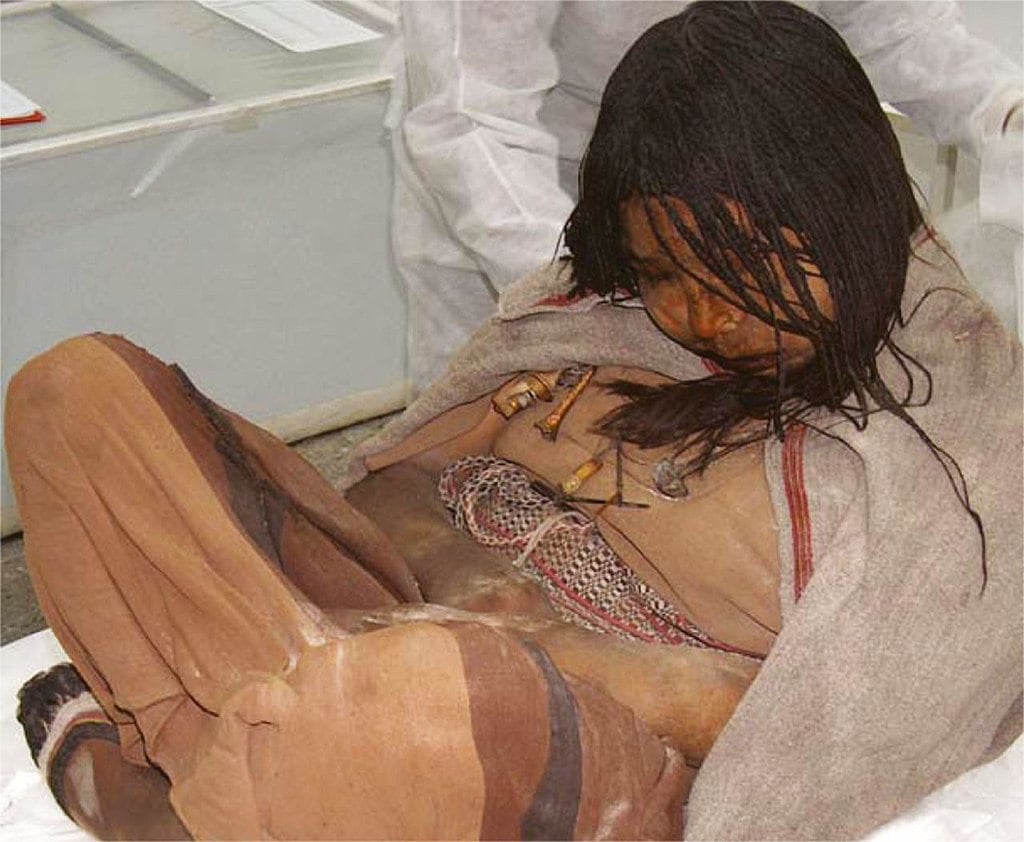
The Children of Llullaillaco, also known as the Llullaillaco Mummies, were three Inca child sacrifices found near the summit of Mount Llullaillaco in the Andes mountains of Argentina.
The mummies were discovered in 1999 by an expedition led by archaeologist Johan Reinhard.
The three mummies were extremely well-preserved due to the freezing temperatures and dry conditions at such a high altitude. They were found in separate graves, and each child was buried with elaborate grave goods, indicating that they were selected for a sacred ritual.
The children were sacrificed as part of a religious ceremony by the Inca civilization, one of the most significant pre-Columbian cultures in South America. The Inca empire, which thrived in the Andean region from the early 15th century until the Spanish conquest in the 16th century, practiced various forms of ritualistic ceremonies, including human sacrifices.
Now, National Geographic reports that the bodies of 13-year-old Llullaillaco Maiden and her younger companions Llullaillaco Boy and Lightning Girl have revealed that mind-altering substances played a part in their deaths and during the year-long series of ceremonial processes that prepared them for their final hours.
The Children of Llullaillaco are three 500-year-old Inca child mummies discovered in 1999 by Johan Reinhard the summit a 6,739 m stratovolcano. The oldest mummy, a girl found to be around the age of fifteen, was dubbed la doncella
[read more: https://t.co/7YG5bxMgfX] pic.twitter.com/YxLzoPf98n
— Massimo (@Rainmaker1973) March 10, 2023
Under biochemical analysis, the Maiden’s hair yielded a record of what she ate and drank during the last two years of her life. This evidence seems to support historical accounts of a few selected children taking part in a year of sacred ceremonies—marked in their hair by changes in food, coca, and alcohol consumption—that would ultimately lead to their sacrifice, National Geographic says.
“In terms of mummies that are known around the world, in my opinion [Maiden] has to be the best preserved of any of the mummies that I’m aware of,” said forensic and archaeological expert Andrew Wilson, of the University of Bradford (U.K.). “She looks almost as if she’s just fallen asleep.”
“This isn’t a desiccated mummy or a set of bones. This is a person; this is a child. And this data that we’ve generated in our studies is really pointing to some poignant messages about her final months and years,” he added.
The discovery of the Children of Llullaillaco has provided valuable insights into the Inca culture and their religious practices.
The practice of human sacrifice, including the sacrifice of children, is undoubtedly considered barbaric from a modern ethical and moral standpoint. It is essential to understand that historical and cultural practices were shaped by the beliefs and values of the societies that engaged in them. Human sacrifice has been documented in various cultures throughout history and across different regions of the world.
The Inca civilization, which was responsible for the Children of Llullaillaco sacrifices, had a complex religious and social structure. They believed in a pantheon of deities, and their religious rituals were deeply intertwined with their understanding of the natural world, cosmology, and their place within the universe.
For the Inca, human sacrifices were seen as offerings to the gods to maintain harmony in the universe, secure agricultural abundance, and protect the community. The sacrifices were considered sacred and played a significant role in their religious practices.
Children of Llullaillaco :
They are three Inca child mummies discovered on 1999 near the summit of Llullaillaco, 6,739m stratovolcano, in Andes mountains on border between Chile and Argentina.
Children were sacrificed in an Inca religious ritual, 1500 AD.#archaeohistories pic.twitter.com/DxhIRCmu8V— Archaeo – Histories (@archeohistories) January 2, 2022
Sacrificed Inca children offer valuable insights
The discovery of the Children of Llullaillaco has provided valuable insights into the lives of these young individuals and offered a glimpse into various aspects of Inca society.
Diet: Analysis of the children’s hair and bone tissues revealed information about their diet. It was found that their last meals consisted of a diet typical of the Inca elite, including a mixture of maize and dried llama meat. This finding suggests that they were likely well-nourished and may have held a high social status within their community.
Health: The mummies were remarkably well-preserved due to the extreme cold and dry conditions of the high-altitude environment where they were buried. This preservation allowed researchers to examine the children’s overall health.
CT scans and X-rays revealed that they did not show signs of physical trauma or injury before their deaths. However, it was noted that they had evidence of chronic respiratory infections, indicating that they may have experienced respiratory issues, possibly due to living at high altitudes.
Social Status: The Children of Llullaillaco were buried with great care and accompanied by valuable grave goods, which suggests that they held a significant social status within the Inca society. The elaborate grave goods included textiles, ceramics, food, and other offerings, emphasizing the importance of their role as sacrifices in a religious ritual.
Age and Gender: The mummies consisted of two girls and one boy, estimated to be between the ages of 13 to 15 years old at the time of their death. The selection of children for sacrifices may have been due to their perceived innocence and purity, making them suitable offerings to the gods.
The study of the Children of Llullaillaco has deepened our understanding of the Inca civilization, their beliefs, and their rituals.
While the practice of human sacrifice is disturbing from a contemporary perspective, it reflects the complex religious and cultural beliefs of the Inca people and highlights the vast differences between their worldviews and modern sensibilities.
See all the latest news from Greece and the world at Greekreporter.com. Contact our newsroom to report an update or send your story, photos and videos. Follow GR on Google News and subscribe here to our daily email!



